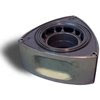"Welp I figured I might as well stop being an assmonkey and might as well show everyone how the real time four wheel drive system works, not to mention, im pulling an all nighter to get my dammn sleep cycle back on track, lemme know what you think. This is all straight from the 89 civic manual. The CRV RT4WD is merely an evolution of this idea, so it uses the same basic principles but is more advanced in how its done.
General
When there is no difference in speed between the No.1 and viscous coupling unit (No.2 propeller shaft) , power is transmitted to the front wheels through the front differential and the front driveshafts. The left driveshaft is connected to the differential by an intermediate shaft, The power is also turned 90 degrees by the transfer gears and transmitted to the No.1 propeller shaft. Whenever there is any speed difference between the No.1 propeller shaft and viscous coupling unit (No.2 propeller shaft), power is transmitted to the rear wheels via the viscous coupling unit, the No.2 and No,3 propeller shafts, the rear differential and the rear driveshafts.
Front Driveshaft
An intermediate shaft equalizes the length and angle of both driveshafts for easier steering on bumpy roads. The driveshaft end of this shaft runs on a bearing which is held by a holder on the engine case. A constant velocity universal joint at each end of the driveshafts ensures quieter operation and longer life. The front wheels run on an angular bearing for reduced friction
Propeller Shaft
The propeller shaft carries power from the transfer to the rear differential. It is of a 2-piece construction and is supported by two rubber mounted bearings. The shaft has four universal joints: one tripod type and three yoke-and-spider type. These joints permit the shaft to lengthen and shorten, as the rear suspension moves.
Viscous Coupling
The viscous coupling unit is located on the front end of the No.2 propeller shaft. It consists of a housing that is connected to the No.1 propeller shaft by a tripod joint. Inside the houning are 79 plates, which have 0.2 mm (0.008 in.) of clearance between one another, surrounded by silicon oil. The 40 housing plates are engaged with the splines in the housing and the 39 hub plates are splined to the shaft. The plates have holes in them to aid in heat dissipation. The viscous coupling unit also contains approximately 10 % air to allow for the thermal expansion of the silicon oil.
Whenever there is any difference in the speed of rotation between the No.1 and No.2 propeller shafts, such as when the front wheels lose traction, there is friction between the housing plates (drive side) and the hub plates (driven side) .This friction is caused by the resistance of the plates sliding against the silicon oil. This resistance between the plates and the silicon oil is what begins to transmit torque from the housing plates to the hub plates and eventually to the rear wheels. This transmission of torque is proportionate to the difference in the speed of rotation of the wheels.
As the difference in propeller shaft speed continues, the temperature of the silicon oil keeps rising. Due to thermal expansion, the pressure inside the viscous coupling unit is also increasing as the temperature rises.
When the pressure becomes high enough, the housing plates begin to contact the hub plates and the engine torque to the rear wheels increases rapidly, as noted in the diagram below. To reduce plate wear, there are spacer rings to limit plate to plate contact."
Source - altoid from http://honda-tech.com/showthread.php?t=411318




